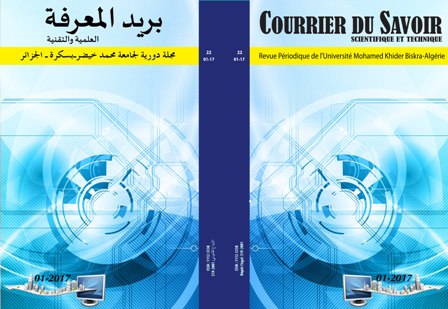RESPONSE SURFACE OPTIMIZATION AND MODELING OF AMMONIUM CHLORIDE ACTIVATION PROCESS OF BENTONITE
Résumé
Ce travail a consisté en l‟optimisation et la modélisation de l‟activation d‟une bentonite avec le chlorure d‟ammonium en utilisant la méthode des plans d‟expériences, et en particulier la méthodologie de surface de réponse (RSM). Un plan central composite orthogonal (CCOD), a permis la détermination de l‟influence des effets simultanés et de l‟interaction des paramètres opératoires sur la surface spécifique (SBET). Les paramètres étudiés sont la température de l'activation (50-90°C), le temps de contact (2-6h), le rapport massique liquide/solide (4-7g/g) et la concentration de la solution d‟activation (1-2 mol L-1).
Les valeurs optimales des paramètres d‟activation donnant une surface spécifique maximale ont pu être déterminées (température : 98.28°C, temps du contact : 6.828 h, rapport massique liquide/solide : 4.627 g/g, concentration de la solution d‟activation : 0.793 mol L-1). La surface spécifique de l‟argile activée sous ses conditions optimales étant de 87.545 m²g-1 et elle est en bonne adéquation avec la valeur prédite par le modèle (89.9 m²g-1). Le modèle de second ordre obtenu pour la surface spécifique de la bentonite activée est en bonne adéquation avec les résultats expérimentaux. Le traitement d‟une bentonite tunisien avec une solution de chlorure d'ammonium provoque une augmentation de la surface spécifique de 47.3 à 87.545 m² g-1 correspondant à une augmentation de 85%.
Références
[2] Tan, D., Yuan, P., Annabi-Bergaya F., Yu, H., Liu, D., Liu, H. and He, H. (2013) „Natural halloysite nanotubes as mesoporous carriers for the loading of ibuprofen‟, Microporous and Mesoporous Materials, Vol. 179, pp.89–98
[3] Mathes, W., Madsen, F.T. and Kahr, G. (1999)
„Sorption of heavy metal cations by Al and Zr-hydroxy-intercalated and pillared clay‟, Clays Clay Miner,. Vol. 47 No.5, pp.617-629.
[4] Andini, S., Cioffi, R., Montagnaro, F., Pisciotta, F. and Santoro, L. (2006) „Simultaneous adsorption of chlorophenol and heavy metal ions on organophilic bentonite‟, Appl. Clay Sci., Vol. 31, pp.126-133.
[5] Gupta, V.K. and Suhas (2009) „Application of low-cost adsorbents for dye removal- A review‟, J. Env. Man., Vol. 90, pp.2313- 2342.
[6] Jiang, J.Q. and Cooper, C. (2003) „Preparation of modified clay adsorbents for the removal of Humic acid‟, Environ. Eng. Sci., Vol. 20 No. 6, pp.581-586.
[7] Weng, L., Van Riemsdijk, W.H., Koopal, L.K. and Hiemstra, T. (2006) „Adsorption of Humic Substances on Goethite: Comparison between Humic Acids and Fulvic Acids‟, Environ. Sci. Technol. Vol. 40 No. 24, pp.7494–7500.
[8] Al-Asheh, S., Banat, F. and Abu-Aitah, L. (2003) „Adsorption of phenol using different types of bentonites‟, Sep. Purif. Technol., Vol. 33, pp.1-10.
[9] Alkaram, U.F., Mukhlis, A. A. and Al-Dujaili, A.H. (2009) „The removal of phenol from aqueous solutions by adsorption using surfactant-modified bentonite and kaolinite‟, J. Hazard. Mater. Vol. 169, pp.324–332.
[10] Amari, A., Gannouni, A., Chlendi, M. and Bellagi, A. (2010) „Optimized activation of bentonite for toluene adsorption‟, Appl. Clay Sci.,Vol. 47, pp.457–461.
[11] Komadel, P. and Madejová, J. (2006) „Acid activated clays‟, In: Bergaya, F., Theng, B.K.G.and Lagaly, G., Handbook of Clay Science. Developments in Clay Sciences, vol. 1. Elsevier, Amsterdam, pp. 263–287.
[12] Hajjaji, M.and Elarfaoui, H. (2009), „Adsorption of methylene blue and zinc ions on raw and acid-activated bentonite from Morocco‟, Appl. Clay Sci. Vol. 46, pp.418–421.
[13] Liyana-Pathirana, C. and Shahidi, F. (2005), „Optimization of extraction of phenolic compounds from wheat using response surface methodology‟, Food Chemistry, Vol. 93, pp.47-56.
[14] Juntachote, T., Berghofer, E., Bauer, F. and Siebenhandl, S. (2006) „The application of response surface methodology to the production of phenolic extracts of lemon grass, galangal, holy basil and rosemary‟, Int. J. Food Sci. Technol., Vol. 41, pp.121-133.
[15] Chan, S.W., Lee, C.Y., Yap, C. F., Wan Aida, W.M. and Ho, C.W. (2009) „Optimization of extraction conditions for phenolic compounds from limau purut (Citrus hystrix) peels‟, Int. Food Research J., Vol. 16, pp.203-213.
[16] Raissi, B. S. and Farsani, R.E. (2009) „Statistical Process Optimization Through Multi-Response Surface Methodology‟, World Acad. Sci., Eng. Technol., Vol. 51, pp.267-271.
[17] Myers, R. H., Montgomery, D.C. and Anderson Cook, C. M. (2002) Response Surface Methodology: process and product optimization using designed experiments,
Third edition, John Wiley & Sons, New-York.
[18] Idri, I., Havet, J.-L., Garcia Fernandez, J.M. and Porte, C. (2013) „Prebiotic di-D-fructose dianhydride-enriched caramels: development of batch process and optimization of operating conditions‟, J. Food Process Eng., Vol. 36, No. 1, pp.95-102.
[19] Lazić, Ž.R. (2004) Design of Experiments in Chemical Engineering, Ed. WILEY-VCH Verlag GmbH & Co. KGaA, Weinheim.
[20] Amini, M., Younesi, H., Bahramifar, N., Lorestani, A.A.Z., Ghorbani, F., Daneshi, A. and Sharifzadeh, M. (2008) „Application of response surface methodology for optimization of lead biosorption in an aqueous solution by Aspergillus niger‟, J. Hazard. Mater, Vol. 154, pp.694–702.
[21] Dean, A. and Voss, D. (1999) Design and Analysis of Experiments, First edition, Springer-Verling, New York.
[22] Srasra, E., Bergaya, F. and Fripiat, J.J. (1994) „Infrared spectroscopy study of tetrahedral and octahedral substitutions in an interstratified illite–smectite clay‟, Clays and Clay Minerals, Vol. 42, pp.237–241.
[23] Madejová, J. and Komadel, P. (2001) „Baseline studies of the Clay Minerals Society source clays: infrared methods‟, Clays and Clay Minerals, Vol. 49, pp.410–432.
[24] Petit, S., Righi, D., Madejová, J. and Decarreau, A. (1999) „Interpretation of the infrared NH4+ spectrum of the NH4+-clays: application to the evaluation of the layer charge‟, Clay Minerals, Vol. 34, pp.543–549.
[25] Box, G.E. P., Hunter, W.G. and Hunter, J.S. (2005) Statistics for Experimenters, Second ed. John Wiley & Sons, New-York.
[26] Benoit, D., Tourbier, Y. and Tourbier, S.G. (1994) Plans d‟expériences: construction et analyse, Ed. Technique documentation Lavoisier.


